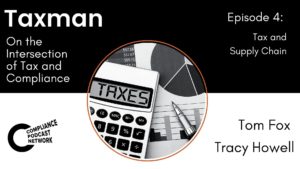
As the Taxman five-part series nears the end, Tom Fox and Tracy Howell tackle an important topic that has become more prominent over the years: tax and supply chain.
How Tax Can Help Supply Chain
Supply chain in a traditional sense focuses on the acquisition of goods, in particular the quality, cost, and delivery. There can be a substantial tax component in each of those steps to help companies attain goods at the lowest possible cost. Consequently, if supply chain does not have a relationship with tax, it can result in additional surprise costs being attached to goods. Data beyond the cost of goods, material, and service can be used to model and predict the additional tax burden so that better procurement decisions can be made.
Mitigating the Risk of Mission Creep
Establishing a connection between tax and supply chain in an organization is good, but the relationship needs to be kept fresh for a positive impact. In a company, people may be focused on so many different things that they forget to interact. Creative people tend to expand their roles and look for goods and services in different locations, which can be the cause of a mission creep. Hence, having constant close interaction between supply chain and tax allows for changes in functionality to be documented and implemented into the organizational framework.
Elements of a Tax-Efficient Supply Chain
Tom and Tracy discuss the elements of a tax-efficient supply chain. This includes:
- Examination of the entire scope of what’s being manufactured and sold to allow the creation of tax opportunities to bring value based on special purpose entities.
- Coordination of transactions in a supply chain with transfer pricing.
- Compliance with tax laws and regulations.
- Documentation of the process.






